#Property Management Software Development Services
Explore tagged Tumblr posts
Text
Explore property management software application costs considerations with including key features, cost factors and time to delivery.
#Property Management Software Application#Property Management Software#Property Management#custom property management software#Property Management Software Development Services#Property Management Application System#Software Application#Software Development#Costs#scottsdale#Arizona#USA#ScottsdaleBizz
0 notes
Text
Benefits of Property Management Software
Property managers of both commercial and residential real estate may find it a challenge to operate and maintain their properties effectively, yet property management software can make operations smoother for everyone involved. From renting multiple units at once to simply tracking tenant information - software solutions have made tracking tenant data less of an administrative hassle with their focus on analytics and lower overhead costs convincing property owners of the benefits of digital management solutions.
Visit us:
#Benefits of Property Management Software#Property Management Software#iot development services#web development
0 notes
Text
DAY 6274
Jalsa, Mumbai Aopr 20, 2025 Sun 11:17 pm
🪔 ,
April 21 .. birthday greetings and happiness to Ef Mousumi Biswas .. and Ef Arijit Bhattacharya from Kolkata .. 🙏🏽❤️🚩.. the wishes from the Ef family continue with warmth .. and love 🌺
The AI debate became the topic of discussion on the dining table ad there were many potent points raised - bith positive and a little indifferent ..
The young acknowledged it with reason and able argument .. some of the mid elders disagreed mildly .. and the end was kind of neutral ..
Blessed be they of the next GEN .. their minds are sorted out well in advance .. and why not .. we shall not be around till time in advance , but they and their progeny shall .. as has been the norm through generations ...
The IPL is now the greatest attraction throughout the day .. particularly on the Sunday, for the two on the day .. and there is never a debate on that ..
🤣
.. and I am most appreciative to read the comments from the Ef on the topic of the day - AI .. appreciative because some of the reactions and texts are valid and interesting to know .. the aspect expressed in all has a legitimate argument and that is most healthy ..
I am happy that we could all react to the Blog contents in the manner they have done .. my gratitude .. such a joy to get different views , valid and meaningful ..
And it is not the end of the day or the debate .. some impressions of the Gen X and some from the just passed Gen .. and some that were never ever the Gen are interesting as well :
The Printing Press (15th Century)
Fear: Scribes, monks, and elites thought it would destroy the value of knowledge, lead to mass misinformation, and eliminate jobs. Reality: It democratized knowledge, spurred the Renaissance and Reformation, and created entirely new industries—publishing, journalism, and education.
⸻
Industrial Revolution (18th–19th Century)
Fear: Machines would replace all human labor. The Luddites famously destroyed machinery in protest. Reality: Some manual labor jobs were displaced, but the economy exploded with new roles in manufacturing, logistics, engineering, and management. Overall employment and productivity soared.
⸻
Automobiles (Early 20th Century)
Fear: People feared job losses for carriage makers, stable hands, and horseshoe smiths. Cities worried about traffic, accidents, and social decay. Reality: The car industry became one of the largest employers in the world. It reshaped economies, enabled suburbia, and created new sectors like travel, road infrastructure, and auto repair.
⸻
Personal Computers (1980s)
Fear: Office workers would be replaced by machines; people worried about becoming obsolete. Reality: Computers made work faster and created entire industries: IT, software development, cybersecurity, and tech support. It transformed how we live and work.
⸻
The Internet (1990s)
Fear: It would destroy jobs in retail, publishing, and communication. Some thought it would unravel social order. Reality: E-commerce, digital marketing, remote work, and the creator economy now thrive. It connected the world and opened new opportunities.
⸻
ATMs (1970s–80s)
Fear: Bank tellers would lose their jobs en masse. Reality: ATMs handled routine tasks, but banks actually hired more tellers for customer service roles as they opened more branches thanks to reduced transaction costs.
⸻
Robotics & Automation (Factory work, 20th century–today)
Fear: Mass unemployment in factories. Reality: While some jobs shifted or ended, others evolved—robot maintenance, programming, design. Productivity gains created new jobs elsewhere.
The fear is not for losing jobs. It is the compromise of intellectual property and use without compensation. This case is slightly different.
I think AI will only make humans smarter. If we use it to our advantage.
That’s been happening for the last 10 years anyway
Not something new
You can’t control that in this day and age
YouTube & User-Generated Content (mid-2000s onward)
Initial Fear: When YouTube exploded, many in the entertainment industry panicked. The fear was that copyrighted material—music, TV clips, movies—would be shared freely without compensation. Creators and rights holders worried their content would be pirated, devalued, and that they’d lose control over distribution.
What Actually Happened: YouTube evolved to protect IP and monetize it through systems like Content ID, which allows rights holders to:
Automatically detect when their content is used
Choose to block, track, or monetize that usage
Earn revenue from ads run on videos using their IP (even when others post it)
Instead of wiping out creators or studios, it became a massive revenue stream—especially for musicians, media companies, and creators. Entire business models emerged around fair use, remixes, and reactions—with compensation built in.
Key Shift: The system went from “piracy risk” to “profit partner,” by embracing tech that recognized and enforced IP rights at scale.
This lead to higher profits and more money for owners and content btw
You just have to restructure the compensation laws and rewrite contracts
It’s only going to benefit artists in the long run
Yes
They can IP it
That is the hope
It’s the spread of your content and material without you putting a penny towards it
Cannot blindly sign off everything in contracts anymore. Has to be a lot more specific.
Yes that’s for sure
“Automation hasn’t erased jobs��it’s changed where human effort goes.”
Another good one is “hard work beats talent when talent stops working hard”
Which has absolutely nothing to with AI right now but 🤣
These ladies and Gentlemen of the Ef jury are various conversational opinions on AI .. I am merely pasting them for a view and an opinion ..
And among all the brouhaha about AI .. we simply forgot the Sunday well wishers .. and so ..














my love and the length be of immense .. pardon

Amitabh Bachchan
107 notes
·
View notes
Text
On February 10, employees at the Department of Housing and Urban Development (HUD) received an email asking them to list every contract at the bureau and note whether or not it was “critical” to the agency, as well as whether it contained any DEI components. This email was signed by Scott Langmack, who identified himself as a senior adviser to the so-called Department of Government Efficiency (DOGE). Langmack, according to his LinkedIn, already has another job: He’s the chief operating officer of Kukun, a property technology company that is, according to its website, “on a long-term mission to aggregate the hardest to find data.”
As is the case with other DOGE operatives—Tom Krause, for example, is performing the duties of the fiscal assistant secretary at the Treasury while holding down a day job as a software CEO at a company with millions in contracts with the Treasury—this could potentially create a conflict of interest, especially given a specific aspect of his role: According to sources and government documents reviewed by WIRED, Langmack has application-level access to some of the most critical and sensitive systems inside HUD, one of which contains records mapping billions of dollars in expenditures.
Another DOGE operative WIRED has identified is Michael Mirski, who works for TCC Management, a Michigan-based company that owns and operates mobile home parks across the US, and graduated from the Wharton School in 2014. (In a story he wrote for the school’s website, he asserted that the most important thing he learned there was to “Develop the infrastructure to collect data.”) According to the documents, he has write privileges on—meaning he can input overall changes to—a system that controls who has access to HUD systems.
Between them, records reviewed by WIRED show, the DOGE operatives have access to five different HUD systems. According to a HUD source with direct knowledge, this gives the DOGE operatives access to vast troves of data. These range from the individual identities of every single federal public housing voucher holder in the US, along with their financial information, to information on the hospitals, nursing homes, multifamily housing, and senior living facilities that HUD helps finance, as well as data on everything from homelessness rates to environmental and health hazards to federally insured mortgages.
Put together, experts and HUD sources say, all of this could give someone with access unique insight into the US real estate market.
Kukun did not respond to requests for comment about whether Langmack is drawing a salary while working at HUD or how long he will be with the department. A woman who answered the phone at TCC Management headquarters in Michigan but did not identify herself said Mirksi was "on leave until July." In response to a request for comment about Langmack’s access to systems, HUD spokesperson Kasey Lovett said, “DOGE and HUD are working as a team; to insinuate anything else is false. To further illustrate this unified mission, the secretary established a HUD DOGE taskforce.” In response to specific questions about Mirski’s access to systems and background and qualifications, she said, “We have not—and will not—comment on individual personnel. We are focused on serving the American people and working as one team.”
The property technology, or proptech, market covers a wide range of companies offering products and services meant to, for example, automate tenant-landlord interactions, or expedite the home purchasing process. Kukun focuses on helping homeowners and real estate investors assess the return on investment they’d get from renovating their properties and on predictive analytics that model where property values will rise in the future.
Doing this kind of estimation requires the use of what’s called an automated valuation model (AVM), a machine-learning model that predicts the prices or rents of certain properties. In April 2024, Kukun was one of eight companies selected to receive support from REACH, an accelerator run by the venture capital arm of the National Association of Realtors (NAR). Last year NAR agreed to a settlement with Missouri homebuyers, who alleged that realtor fees and certain listing requirements were anticompetitive.
“If you can better predict than others how a certain neighborhood will develop, you can invest in that market,” says Fabian Braesemann, a researcher at the Oxford Internet Institute. Doing so requires data, access to which can make any machine-learning model more accurate and more monetizable. This is the crux of the potential conflict of interest: While it is unclear how Langmack and Mirski are using or interpreting it in their roles at HUD, what is clear is that they have access to a wide range of sensitive data.
According to employees at HUD who spoke to WIRED on the condition of anonymity, there is currently a six-person DOGE team operating within the department. Four members are HUD employees whose tenures predate the current administration and have been assigned to the group; the others are Mirski and Langmack. The records reviewed by WIRED show that Mirski has been given read and write access to three different HUD systems, as well as read-only access to two more, while Langmack has been given read and write access to two of HUD’s core systems.
A positive, from one source’s perspective, is the fact that the DOGE operatives have been given application-level access to the systems, rather than direct access to the databases themselves. In theory, this means that they can only interact with the data through user interfaces, rather than having direct access to the server, which could allow them to execute queries directly on the database or make unrestricted or irreparable changes. However, this source still sees dangers inherent in granting this level of access.
“There are probably a dozen-plus ways that [application-level] read/write access to WASS or LOCCS could be translated into the entire databases being exfiltrated,” they said. There is no specific reason to think that DOGE operatives have inappropriately moved data—but even the possibility cuts against standard security protocols that HUD sources say are typically in place.
LOCCS, or Line of Credit Control System, is the first system to which both DOGE operatives within HUD, according to the records reviewed by WIRED, have both read and write access. Essentially HUD’s banking system, LOCCS “handles disbursement and cash management for the majority of HUD grant programs,” according to a user guide. Billions of dollars flow through the system every year, funding everything from public housing to disaster relief—such as rebuilding from the recent LA wildfires—to food security programs and rent payments.
The current balance in the LOCCS system, according to a record reviewed by WIRED, is over $100 billion—money Congress has approved for HUD projects but which has yet to be drawn down. Much of this money has been earmarked to cover disaster assistance and community development work, a source at the agency says.
Normally, those who have access to LOCCS require additional processing and approvals to access the system, and most only have “read” access, department employees say.
“Read/write is used for executing contracts and grants on the LOCCS side,” says one person. “It normally has strict banking procedures around doing anything with funds. For instance, you usually need at least two people to approve any decisions—same as you would with bank tellers in a physical bank.”
The second system to which documents indicate both DOGE operatives at HUD have both read and write access is the HUD Central Accounting and Program System (HUDCAPS), an “integrated management system for Section 8 programs under the jurisdiction of the Office of Public and Indian Housing,” according to HUD. (Section 8 is a federal program administered through local housing agencies that provides rental assistance, in the form of vouchers, to millions of lower-income families.) This system was a precursor to LOCCS and is currently being phased out, but it is still being used to process the payment of housing vouchers and contains huge amounts of personal information.
There are currently 2.3 million families in receipt of housing vouchers in the US, according to HUD’s own data, but the HUDCAPS database contains information on significantly more individuals because historical data is retained, says a source familiar with the system. People applying for HUD programs like housing vouchers have to submit sensitive personal information, including medical records and personal narratives.
“People entrust these stories to HUD,” the source says. “It’s not data in these systems, it’s operational trust.”
WASS, or the Web Access Security Subsystem, is the third system to which DOGE has both read and write access, though only Mirski has access to this system according to documents reviewed by WIRED. It’s used to grant permissions to other HUD systems. “Most of the functionality in WASS consists of looking up information stored in various tables to tell the security subsystem who you are, where you can go, and what you can do when you get there,” a user manual says.
“WASS is an application for provisioning rights to most if not all other HUD systems,” says a HUD source familiar with the systems who is shocked by Mirski’s level of access, because normally HUD employees don’t have read access, let alone write access. “WASS is the system for setting permissions for all of the other systems.”
In addition to these three systems, documents show that Mirski has read-only access to two others. One, the Integrated Disbursement and Information System (IDIS), is a nationwide database that tracks all HUD programs underway across the country. (“IDIS has confidential data about hidden locations of domestic violence shelters,” a HUD source says, “so even read access in there is horrible.”) The other is the Financial Assessment of Public Housing (FASS-PH), a database designed to “measure the financial condition of public housing agencies and assess their ability to provide safe and decent housing,” according to HUD’s website.
All of this is significant because, in addition to the potential for privacy violations, knowing what is in the records, or even having access to them, presents a serious potential conflict of interest.
“There are often bids to contract any development projects,” says Erin McElroy, an assistant professor at the University of Washington. “I can imagine having insider information definitely benefiting the private market, or those who will move back into the private market,” she alleges.
HUD has an oversight role in the mobile home space, the area on which TCC Management, which appears to have recently wiped its website, focuses. "It’s been a growing area of HUD’s work and focus over the past few decades," says one source there; this includes setting building standards, inspecting factories, and taking in complaints. This presents another potential conflict of interest.
Braesemann says it’s not just the insider access to information and data that could be a potential problem, but that people coming from the private sector may not understand the point of HUD programs. Something like Section 8 housing, he notes, could be perceived as not working in alignment with market forces—“Because there might be higher real estate value, these people should be displaced and go somewhere else”—even though its purpose is specifically to buffer against the market.
Like other government agencies, HUD is facing mass purges of its workforce. NPR has reported that 84 percent of the staff of the Office of Community Planning and Development, which supports homeless people, faces termination, while the president of a union representing HUD workers has estimated that up to half the workforce could be cut The chapter on housing policy in Project 2025—the right-wing playbook to remake the federal government that the Trump administration appears to be following—outlines plans to massively scale back HUD programs like public housing, housing assistance vouchers, and first-time home buyer assistance.
16 notes
·
View notes
Text







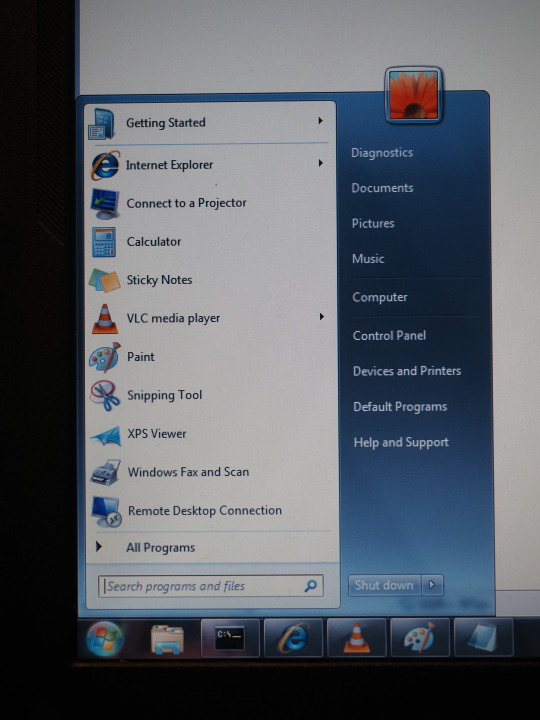

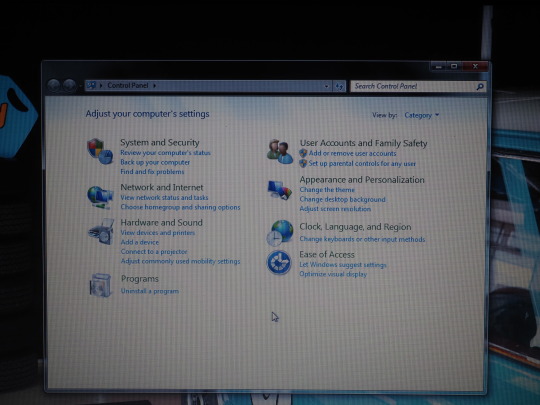


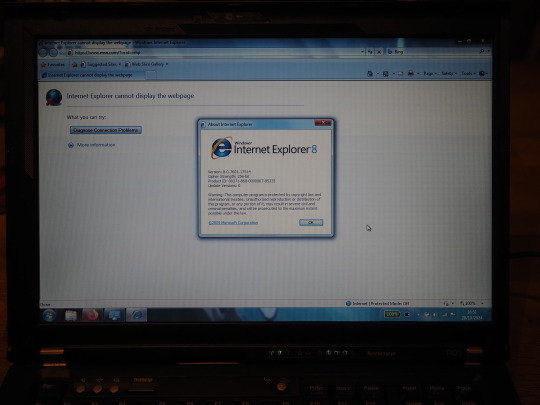



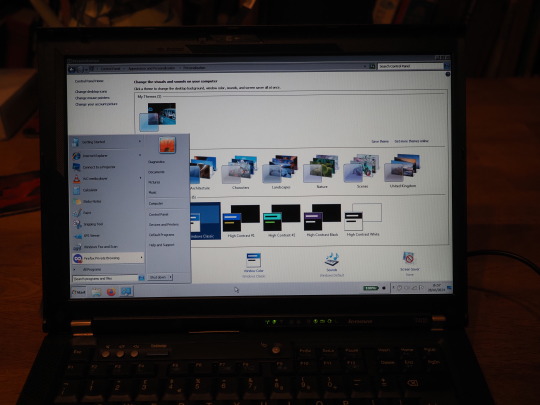











28.10.24
Chris asked me to try and help his friend Woody with a laptop problem.
The laptop, which is a Lenovo ThinkPad T400 from 2008 has been used for car diagnostics for many years.
Woody wanted to upgrade the diagnostic software, but found that the laptop wouldn't connect to the internet.
When I examined the laptop, I saw that it was running Microsoft Windows 7, which had never been updated since it was installed in 2015. The machine had previously ran Windows Vista (2007).
This meant that it was running Internet Explorer 8 which ended support in 2020 and is known to have many security flaws which make it basically unusable.
The laptop had been configured to disable automatic update. It is likely that automatic updates would no longer work in any case because they depend on the underline Internet Explorer Browser.
I managed to install a version of Mozilla's Firefox Browser, one that still supports Windows 7 by downloading it onto a USB stick on a different computer.
I installed the 32-bit version of Firefox 115 ESR, which is the last supported version for Windows 7. I chose the 32-bit version because this edition of Windows 7 is 32-bit instead of 64-bit.
Using Firefox, I successfully connected to the internet and played a YouTube video, which you can see in the video below.
I also had a look at the various themes that the user could apply to the look and feel. Windows 7 was the last version to feature a user selectable Classic theme and system sound effects!
The default theme was called Aero. Also featured in Vista, this theme featured translucency, glass effects that required a decent PC at the time of its release.
The taskbar in Windows 7 was called the 'Super bar' as it allowed for pinning applications by default and was larger in size than previous versions. This could all be configured in the properties dialogue, which would be moved into the settings in Windows 10.
I gave the laptop back to Chris to give to Woody. He will now be able to download and install the updated diagnostics software.
Ideally, Woody should upgrade the laptop to a later version of Windows such as Windows 8.1 or 10, but even if he doesn't, it should still continue to work provided he does not connect it to the network.
It was fun trying out Windows 7 once again.
https://en.wikipedia.org/wiki/Windows_7
Windows 7 was released in 2009 and was a successful operating system like Windows XP which was released in 2001!
Windows 7 intended to fix the issues in Windows Vista.
Its development started in 2006, with a beta release in 2008 under the codename Vienna. Its first and only service pack (SP1) came out in 2011.
Windows 7 used the Vista kernel, which is still used today as a base for compatibility in all later versions of Windows.
Mainstream support for Windows 7 ended in 2015 and extended support ended at the start of 2020.
Chris took the Lenovo laptop back to Woody and they successfully downloaded the diagnostics software through the Firefox browser and it worked perfectly.
A complete success!
5 notes
·
View notes
Text
25 Passive Income Ideas to Build Wealth in 2025
Passive income is a game-changer for anyone looking to build wealth while freeing up their time. In 2025, technology and evolving market trends have opened up exciting opportunities to earn money with minimal ongoing effort. Here are 25 passive income ideas to help you grow your wealth:
1. Dividend Stocks
Invest in reliable dividend-paying companies to earn consistent income. Reinvest dividends to compound your returns over time.
2. Real Estate Crowdfunding
Join platforms like Fundrise or CrowdStreet to invest in real estate projects without the hassle of property management.
3. High-Yield Savings Accounts
Park your money in high-yield savings accounts or certificates of deposit (CDs) to earn guaranteed interest.
4. Rental Properties
Purchase rental properties and outsource property management to enjoy a steady cash flow.
5. Short-Term Rentals
Leverage platforms like Airbnb or Vrbo to rent out spare rooms or properties for extra income.
6. Peer-to-Peer Lending
Lend money through platforms like LendingClub and Prosper to earn interest on your investment.
7. Create an Online Course
Turn your expertise into an online course and sell it on platforms like Udemy or Teachable for recurring revenue.
8. Write an eBook
Publish an eBook on Amazon Kindle or similar platforms to earn royalties.
9. Affiliate Marketing
Promote products or services through a blog, YouTube channel, or social media and earn commissions for every sale.
10. Digital Products
Design and sell digital products such as templates, printables, or stock photos on Etsy or your website.
11. Print-on-Demand
Use platforms like Redbubble or Printful to sell custom-designed merchandise without inventory.
12. Mobile App Development
Create a useful app and monetize it through ads or subscription models.
13. Royalties from Creative Work
Earn royalties from music, photography, or artwork licensed for commercial use.
14. Dropshipping
Set up an eCommerce store and partner with suppliers to fulfill orders directly to customers.
15. Blogging
Start a niche blog, grow your audience, and monetize through ads, sponsorships, or affiliate links.
16. YouTube Channel
Create a YouTube channel around a specific niche and earn through ads, sponsorships, and memberships.
17. Automated Businesses
Use tools to automate online businesses, such as email marketing or subscription box services.
18. REITs (Real Estate Investment Trusts)
Invest in REITs to earn dividends from real estate holdings without owning property.
19. Invest in Index Funds
Index funds provide a simple way to earn passive income by mirroring the performance of stock market indexes.
20. License Software
Develop and license software or plugins that businesses and individuals can use.
21. Crypto Staking
Participate in crypto staking to earn rewards for holding and validating transactions on a blockchain network.
22. Automated Stock Trading
Leverage robo-advisors or algorithmic trading platforms to generate passive income from the stock market.
23. Create a Membership Site
Offer exclusive content or resources on a membership site for a recurring subscription fee.
24. Domain Flipping
Buy and sell domain names for a profit by identifying valuable online real estate.
25. Invest in AI Tools
Invest in AI-driven platforms or create AI-based products that solve real-world problems.
Getting Started
The key to success with passive income is to start with one or two ideas that align with your skills, interests, and resources. With dedication and consistency, you can build a diversified portfolio of passive income streams to secure your financial future.
2 notes
·
View notes
Text
Anisha Sharma & Associates: Comprehensive Business & Finance Solutions for Every Need
Comprehensive finance and legal solutions with Anisha Sharma & Associates

Anisha Sharma & Associates is a business and finance company that delivers a wide range of core and specialized services. With a team of seasoned professionals, the firm ensures that businesses, individuals, and entrepreneurs have access to reliable and expert financial solutions. Their commitment to providing tailored guidance in various domains makes them a trusted partner for numerous clients. Below is an overview of their core and specialized services.
Core Services:
1.Accounts: Maintaining accurate and timely financial records is crucial for every business. Anisha Sharma & Associates ensures that their clients’ accounting needs are managed with precision, enabling seamless financial operations.
2.Audit: Through detailed audits, the firm provides clients with insights into their financial health. Their audit services help identify areas of improvement and ensure compliance with regulatory requirements.
3.Trademark: Protecting intellectual property is vital for brand success. The firm helps clients register and safeguard their trademarks, ensuring that their brand identity is secure and recognized.
4.ROC (Registrar of Companies): Navigating company registration and ROC compliance can be complex. Anisha Sharma & Associates simplifies this process, ensuring all filings and compliances are met, avoiding legal complications.
5.License & Registration: Securing the appropriate licenses and registrations is essential for any business. The firm assists in obtaining licenses that enable businesses to operate legally and efficiently.
6.Loans: Access to finance is a key driver for business growth. Anisha Sharma & Associates assists clients in securing loans, offering guidance on the most suitable options to meet their needs.
7.Income Tax: Their income tax services ensure that clients remain compliant with tax laws while minimizing their tax liabilities through expert planning and timely filings.
8.GST: Goods and Services Tax (GST) compliance can be challenging for businesses. The firm ensures that all GST filings are accurate and up-to-date, allowing businesses to avoid penalties and manage taxes efficiently.
9.Consultancy: The company provides tailored consultancy services, offering expert advice to help businesses grow, streamline operations, and optimize financial strategies.
10.Outsourcing: For businesses looking to delegate their accounting and finance processes, the firm offers comprehensive outsourcing services that help reduce costs and improve efficiency.
11.DSC & Token: Digital signatures (DSC) are essential for secure electronic transactions. The firm assists clients in obtaining DSCs and tokens, ensuring the safe and authorized use of digital platforms.
12.Software: Anisha Sharma & Associates offers customized software solutions to streamline business processes, enhance productivity, and ensure smooth financial operations.
Specialized Services:
1.Stock Broking & Advisory: Offering guidance on investments and stock market trading, the firm helps clients make informed decisions and maximize returns on their portfolios.
2.Website & Digital: The digital landscape is evolving rapidly. The firm provides website development and digital solutions that help businesses establish a strong online presence and reach their target audience.
3.Real Estate Placement Consulting: Whether for buying, selling, or leasing, the firm’s real estate consulting services ensure that clients make profitable and well-informed decisions.
4.PF & ESI: Managing Provident Fund (PF) and Employee State Insurance (ESI) is crucial for employee welfare. Anisha Sharma & Associates ensures that clients remain compliant with these regulations while optimizing benefits for their workforce.
5.Civil & Criminal Lawyer: In addition to financial services, the firm provides legal support for both civil and criminal matters, ensuring comprehensive legal representation for their clients.
Why Choose Anisha Sharma & Associates?
Anisha Sharma & Associates stands out for its comprehensive range of services, combining financial expertise with legal acumen. Their client-centric approach ensures that each business or individual receives personalized solutions tailored to their specific needs. Whether managing day-to-day financial operations, navigating the complexities of compliance, or seeking legal representation, Anisha Sharma & Associates is a reliable partner for long-term success.
2 notes
·
View notes
Text
What is Enterprise Fleet Management?

As is revealed in today’s world business environment, any organization must manage its resources appropriately. Thus, for companies and firms having major operations related to transportation and logistics, it becomes even more essential to manage their fleets.
Now, let’s start with the basics: what does enterprise fleet management mean? Now let’s discuss this idea and figure out how it can be of great benefit to the business processes.
Understanding what is Enterprise Fleet Management
Fleet management within an enterprise could be described as a strategic approach to managing and supervising such a company's vehicle fleet. The areas include its acquisition and maintenance, driver and vehicle management, and laws governing the automobile industry. Fleet management is prospective to optimize the operating costs and enhance the safety and productivity of both fleets and their drivers.
In an enterprise environment, fleet management goes beyond tracking the vehicles; it is more about getting improved ways of running organizations. Fleet management is important irrespective of whether it involves delivery vans, trucks, or even corporate cars if the business owns a set of cars for business use.
The outcome highlights the fundamental issues of fleet management.
Vehicle Acquisition and Disposal: Picking the correct car for your fleet, beginning from procurement to the time of disposal.
Maintenance and Repair: Managing to schedule vehicles for maintenance and repairs regularly to make sure that they are in good working condition to reduce time loss.
Fuel Management: Fuel efficiency management by controlling consumption and considering these to minimize fuel expenses by using fuel-efficient driving techniques and other energy resources.
Driver Management: Incorporating training and supervision of drivers as well as planning meals nt to support safety, compliance, and efficiency among the drivers.
Compliance and Risk Management: The safety of all the used vehicles as well as the used drivers with brutal and international requirements and managing of risk exposures of operating fleets.
Here we will discuss the concept of Fleet Management Software. Inefficiently managing all these components, many businesses turn to the use of fleet management software. This is because it acts as a platform for accessing any information regarding the fleet, including real-time data and automated operations of the fleet.
Key Features of Fleet Management Software
GPS Tracking: Precise vehicle location in real-time to increase efficiency and controllers.
Maintenance Scheduling: Schedule reminders in case of preventive maintenance and repairs to avoid ‘bottlenecks Management: Proper equipment that tracks fuel usage and gives an indication of wasteful activities.
Compliance Management: Material properties garages need to comply with set safety measures as well as regulatory requirements.
Driver Performance Monitoring: Measures to monitor and measure drivers’s performance, detect their training requirements, and incentivize them over safe behavior on roads.
Why Enterprise Fleet Management is So Important
To large companies, fleet management is not only limited to planning on how to ensure that vehicles are running. It’s about being able to harness data and technology in a way that will put you ahead of the competition. Effective management of fleets is known to have numerous benefits, such as cutting costs, satisfying customers, and reducing risks involving drivers and cars, among others.
However, due to emerging issues such as global warming, companies are now focusing on the use of fleets to be environmentally friendly. This is done through the optimization of routes, timely maintenance of vehicles, and training of the drivers to ensure they are conscious of the impact they make on the environment.
Being a web-based service, the most advantageous aspect related to an FMS or a Fleet Management Software Development Service is that it can be easily and effectively utilized across the corporate fleet range.
This has led to the increasing need for the development of fleet management software to be able to meet the expanding market need. Custom software, as the name suggests, is designed to improve organizational operations to suit a company’s needs, making it more flexible than packaged software.
A fleet management software development service typically includes
Consultation and Needs Assessment: Ah, awareness of the particular requirements and objectives of your fleet. You need to hire a professional fleet management software development company.
Custom Software Development: Constructing a custom fit that incorporates into the complex structures of the organization and fits the needs of the organization perfectly.
Integration with IoT Devices: The use of Internet of Things (IoT) devices such as GPS trackers or sensors to input real-time information and data.
Ongoing Support and Maintenance: Needed to make sure the software will continue to include all the features and incorporate the latest technologies and that it will cover all current needs of the business.
Conclusion
Okay, then, Fleet management is a system that encompasses all activities that involve control of a company’s fleet of vehicles with the use of the latest technologies in software and quality practices. Fleet management is not only a good idea but a necessity for any business that depends on transportation, where proper management of the company’s fleet is critical to achieving success.
Let it be a handful of vehicles or a multitude, the appropriate strategy in fleet management as enhanced by software changes the equation, provides steps towards optimizing your operations, lowers costs, and enhances the performance of an organization. The fast advancement of technology means that the means and ways used in the implementation of the strategies by the f managers are ever-changing and therefore a very promising industry to follow.
#business growth#fleet management#fleet maintenance#enterprise software#enterprise application development#business solutions#software#trending#viralpost#viral trends
2 notes
·
View notes
Text
A Comprehensive Guide to the Top Industries Attracting FDI in India

India has emerged as one of the most attractive destinations for Foreign Direct Investment (FDI) in recent years, thanks to its robust economic growth, favorable demographics, and ongoing policy reforms. FDI plays a crucial role in stimulating economic development by bringing in capital, technology, and expertise. In this comprehensive guide, we will delve into the top industries that are attracting FDI in India.
1. Information Technology (IT) and Software Services:
India's IT industry has been a pioneer in attracting FDI, fueling the country's economic growth and creating millions of jobs. With a large pool of skilled IT professionals, cost-effective services, and a conducive business environment, India continues to be a global hub for software development, IT outsourcing, and business process outsourcing (BPO).
India's Information Technology (IT) and software services industry have been pivotal in attracting Foreign Direct Investment (FDI) due to several key factors:
1. Skilled Workforce:
India boasts a vast pool of highly skilled IT professionals, including software engineers, developers, and project managers. The country's education system emphasizes STEM (Science, Technology, Engineering, and Mathematics) fields, producing a large number of graduates with expertise in computer science and information technology. This skilled workforce is instrumental in delivering high-quality software development, IT outsourcing, and business process outsourcing (BPO) services to clients worldwide.
2. Cost-Effectiveness:
The cost of labor in India is significantly lower compared to developed countries, making it an attractive destination for outsourcing IT projects and services. Foreign companies can leverage India's cost-effective labor market to reduce their operational expenses while maintaining high standards of quality and efficiency. This cost advantage has been a major driver for multinational corporations to set up offshore development centers and service delivery hubs in India.
3. Conducive Business Environment:
India offers a conducive business environment for IT companies, characterized by liberalized policies, supportive government initiatives, and a well-established legal framework. The government has implemented various reforms to promote ease of doing business, simplify regulatory procedures, and encourage foreign investment in the IT sector. Additionally, initiatives such as Digital India and Make in India have further propelled the growth of the IT industry by fostering innovation, entrepreneurship, and technology adoption.
4. Global Reputation:
Over the years, India has built a strong reputation as a leading destination for IT and software services globally. Indian IT companies have demonstrated expertise in delivering cutting-edge solutions, leveraging emerging technologies, and meeting the diverse needs of clients across industries. This reputation has attracted multinational corporations to partner with Indian firms, outsource IT projects, and establish long-term collaborations for software development, maintenance, and support services.
5. Innovation and R&D:
India's IT industry is not just about cost arbitrage; it is also a hub for innovation, research, and development. Many global technology firms have set up innovation centers, research labs, and technology incubators in India to tap into the country's talent pool and drive innovation. These centers focus on developing next-generation technologies, conducting R&D activities, and creating intellectual property in areas such as artificial intelligence, machine learning, blockchain, and cloud computing.
2. Telecommunications:
India's telecommunications sector has witnessed significant FDI inflows, driven by the rapid expansion of mobile and internet services. With a massive consumer base and increasing smartphone penetration, telecom companies are investing heavily in network infrastructure, spectrum auctions, and digital technologies to capitalize on the growing demand for data services.
India's telecommunications sector has emerged as a prominent recipient of Foreign Direct Investment (FDI) due to several key factors:
1. Expanding Market Potential:
India has one of the largest telecommunications markets in the world, with over a billion mobile subscribers and rapidly increasing internet penetration. The country's vast population, growing middle class, and rising disposable incomes have fueled the demand for voice, data, and digital services across urban and rural areas. This immense market potential offers lucrative opportunities for telecom companies to invest in network infrastructure, spectrum allocation, and innovative services to cater to the diverse needs of consumers.
2. Mobile Revolution:
India has witnessed a mobile revolution in recent years, driven by affordable smartphones, competitive tariffs, and widespread adoption of mobile internet services. The proliferation of mobile devices has transformed communication, commerce, and entertainment, creating new business models and revenue streams for telecom operators. Foreign investors recognize India's mobile-first market dynamics and are keen to capitalize on the growing demand for voice calls, messaging apps, mobile data, and value-added services.
3. Digital Connectivity:
The government's Digital India initiative aims to bridge the digital divide and promote inclusive growth by ensuring broadband connectivity to all citizens. This ambitious program has spurred investments in fiber-optic networks, 4G/5G infrastructure, and rural broadband initiatives to enhance digital connectivity and enable access to digital services in remote areas. Foreign telecom companies view India's digital transformation as an opportunity to deploy advanced technologies, improve network coverage, and deliver high-speed internet services to underserved communities.
4. Spectrum Auctions:
Spectrum is a critical asset for telecom operators to expand their network capacity, improve service quality, and offer new services to customers. India's spectrum auctions provide an opportunity for telecom companies to acquire additional spectrum bands and strengthen their market position. Foreign investors participate in these auctions to acquire spectrum licenses and invest in network upgrades, spectrum refarming, and technology modernization to enhance their competitiveness in the market.
5. Convergence of Services:
The convergence of telecommunications with other sectors such as media, entertainment, and technology is driving investment opportunities in integrated services and content delivery platforms. Foreign telecom operators are exploring partnerships, mergers, and acquisitions with content providers, OTT (Over-the-Top) platforms, and digital media companies to offer bundled services, streaming content, and personalized experiences to subscribers.
6. Policy Reforms:
The Indian government has introduced several policy reforms to liberalize the telecom sector, attract foreign investment, and promote healthy competition. Initiatives such as National Digital Communications Policy (NDCP), ease of doing business reforms, and regulatory clarity have created a favorable investment climate for telecom companies. Foreign investors are encouraged by the government's commitment to reforming regulations, promoting innovation, and fostering a vibrant telecom ecosystem in India.
3. Automobiles and Automotive Components:
The Indian automotive industry has attracted substantial FDI from global automakers and component manufacturers seeking to establish manufacturing facilities, R&D centers, and distribution networks. India's competitive manufacturing costs, skilled workforce, and improving infrastructure have positioned it as a key player in the global automotive market.
4. Pharmaceuticals and Healthcare:
The pharmaceutical sector in India has been a magnet for FDI due to its strong regulatory framework, large market potential, and cost advantages in drug manufacturing. Foreign pharmaceutical companies are investing in research collaborations, production facilities, and distribution networks to tap into India's growing healthcare needs and leverage its expertise in generic drugs.
5. Renewable Energy:
India's ambitious renewable energy targets and supportive government policies have attracted significant FDI inflows into the sector. Foreign investors are investing in solar, wind, hydro, and biomass projects, driven by India's vast renewable energy potential, favorable regulatory environment, and growing demand for clean energy solutions.
6. Retail and E-Commerce:
India's retail and e-commerce sector has witnessed a surge in FDI with the liberalization of FDI policies and the rapid growth of online shopping. Global retail giants are partnering with Indian companies or establishing their own operations to tap into the country's burgeoning consumer market and rising middle-class population.
7. Real Estate and Construction:
The Indian real estate sector continues to attract FDI, driven by urbanization, infrastructure development, and demand for commercial and residential properties. Foreign investors are participating in joint ventures, development projects, and real estate investment trusts (REITs) to capitalize on India's growing urban centers and infrastructure needs.
8. Financial Services:
India's financial services industry is experiencing a steady influx of FDI, driven by liberalization measures, digital transformation, and increasing investor interest. Foreign banks, insurance companies, and fintech startups are expanding their presence in India to cater to the growing demand for banking, insurance, and digital payment services.
9. Food Processing:
The food processing sector in India has attracted FDI due to its vast agricultural resources, changing consumer preferences, and government incentives. Foreign companies are investing in food processing plants, cold chains, and distribution networks to meet the rising demand for processed and packaged food products in India.
10. Infrastructure:
India's infrastructure sector offers immense opportunities for FDI across various segments such as transportation, energy, and urban development. Foreign investors are participating in public-private partnerships (PPPs), infrastructure projects, and investment funds to address India's infrastructure gaps and support its economic growth.
In conclusion, India offers a diverse range of investment opportunities across various industries, making it an attractive destination for FDI. With a growing economy, favorable demographics, and ongoing policy reforms, India continues to attract foreign investors seeking high returns and long-term growth prospects. However, investors need to navigate regulatory challenges, market dynamics, and cultural nuances to succeed in India's competitive business landscape.
This post was originally published on: Foxnangel
#fdi in india#fdi investment in india#foreign invest in india#foreign direct investment#it industry#foreign companies#renewable energy#green energy#foxnangel#invest in india
2 notes
·
View notes
Text
Smart Growth: Cost-Saving Expansion Tactics for Startups

For any growing startup, scaling up in a cost-effective way is a dream and a dilemma. These young businesses aim to boost their reach and operations. The big question is: Can they increase their team size without burning through their budget? This is where staff augmentation comes in. It's a practical, flexible method that lets startups grow without breaking the bank.
A Look at Startup Expansion Pitfalls
Take a fictional startup, ByteWave, as a case in point. Three university pals had a fantastic idea for a cloud-based service and ByteWave was born. After a year, their user base ballooned to 50,000. This explosive growth brought a heap of operational headaches. ByteWave's tiny 12-member team was swamped, battling to stay afloat amidst demands for customer support, software updates, and fresh feature rollouts.
Traditional hiring seemed the logical move. However, it's a costly option. The Society for Human Resource Management estimates the average cost of recruiting a new U.S. worker is $4,129, taking an average of 42 days. For a startup like ByteWave, this approach was simply out of reach in terms of time and budget.
The Benefits of Staff Augmentation
Staff augmentation is a far more efficient solution. It gives startups the flexibility to temporarily hire skilled personnel for key roles. ByteWave could quickly bring in specialist developers and customer service agents for specific projects. This gave the founders the ability to dynamically scale their team, tackling particular problems without the delays and costs of full-time recruitment.
A Smart Financial Move
Staff augmentation brings significant savings. Deloitte's research shows businesses can save as much as 30% in labor costs by adopting flexible staffing models. These cost cuts result from reduced essential overheads like benefits, office space, and training costs. Plus, it speeds up time-to-market. Deloitte's study also discovered projects are completed 20-25% quicker with staff augmentation, giving startups a crucial competitive edge.
Success Stories
Numerous real-world examples demonstrate how startups have used staff augmentation effectively:
Airbnb: To boost user appeal, Airbnb brought in freelance photographers to produce quality property listings, enhancing the platform's appeal without having to recruit full-time photographers.
Slack: During a critical period of rapid growth, Slack used remote contractors to provide 24/7 customer support, avoiding the costs of a large, permanent team.
Uber: Expanding into new locations, Uber used local contractors for tasks such as driver onboarding and market research, allowing fast growth without the long-term overheads of permanent local staffing.
Steps to Implement Staff Augmentation
If you're a startup considering staff augmentation, follow these practical steps:
Be Transparent: Define the needed skills and roles. This helps you find the right talent.
Choose Wisely: Partner with reliable staffing agencies or platforms that are familiar with your industry. They can quickly hook you up with vetted professionals.
Foster a Team Spirit: Treat augmented staff as integral team members. Make sure they attend meetings, have the necessary tools and keep communication lines open.
Be Clear: Set out the scope, deadlines, and deliverables for each project. This ensures all parties are on the same page and promotes effective collaboration.
Share Knowledge: Ensure the knowledge and experience that the temporary staff bring is shared with your permanent team.
Challenge Navigation
Staff augmentation, while beneficial, is not without its obstacles. Here's how to address them:
Building the Team: Temporary staff might not naturally fit into your company culture. To bridge this gap, include them in team activities and clearly communicate your values and aims.
Maintaining Standards: Keep high-quality work by setting clear quality benchmarks, and conducting regular work reviews.
Data Protection: Safeguard critical information with strict NDAs and limit access to crucial systems.
Employee Relations: Permanent team members might feel uneasy about temporary staff. Be clear about the roles of augmented staff and stress that they are an additional resource, not a threat to the core team.
The Way Forward
The move towards flexible work arrangements is increasing. An Upwork study predicts that by 2028, 73% of all teams will include remote workers. This factors make staff augmentation an appealing option for startups. Tools for remote project management and communication like Trello, Asana, and Slack are helping facilitate this shift, allowing efficient collaboration regardless of location.
Conclusion
Staff augmentation can be a lifesaver for startups trying to expand while preserving their budgets. It permits them to bring in specialized skills as needed, accelerate growth, and compete effectively without long-term financial commitments.
2 notes
·
View notes
Text
Navigating the Financial Maze: Self-Employed Proof of Income
Whether you're applying for a loan, trying to lease an apartment, filing taxes, or simply looking to keep your financial records in order, having the proper documentation is essential. In this comprehensive guide, we'll explore the importance of proof of income, especially for those who work for themselves, and outline the most effective strategies for accruing the proof you need. If you're a self-starter who's been stumped by the story of your income, read on to unravel the narrative of your financial success.
Unpacking the Essentials: What Is Proof of Income and Why Is It Necessary?
What Is Proof of Income?
Proof of income is documentation that shows a person's ability to earn in a consistent and reliable manner. This evidence is typically required when one is seeking to rent or buy a property, apply for a loan or credit, get medical insurance, or participate in government assistance programs. Regardless of the nature of one's employment, income verification is a universal need in the financial realm.
Why Do You Need It?
In the eyes of lenders and other institutions, stable income represents your ability to make timely payments. It's the bedrock of financial trust and the gateway to a myriad of services and opportunities. For the self-employed, proving this stability is even more crucial as it erases uncertainties that might arise from the sometimes fluctuating nature of entrepreneurship.
How to prove income when self employed?
1. Organize Your Financial Statements
Begin with your bank statements and regularly update them to reflect your income streams. Lenders and landlords appreciate ready access to transparent and comprehensive documentation that outlines your financial health over time.
2. Prepare Tax Returns
Income tax returns are a gold standard in the financial world. Ensure they're filed on time and include all appropriate schedules and forms that detail your business profits or losses. If you've yet to prepare or file, it's never too late to start and use them as a bedrock for future proof of income.
3. Develop Pro Forma Statements
Pro forma financial statements are projections based on potential future incomes and expenditures. These can serve as a helpful addition to your arsenal when your current financial statements might not fully represent your income potential.
4. Utilize Contracts and Invoices
Keep a concise record of all your business transactions. Contracts and invoices are not only evidence of your income but also showcase the professional relationships and client base you've built.
5. Consider Profit & Loss Statements
Profit and loss statements encapsulate business profitability by summarizing revenues, costs, and expenses during a specific time frame. They provide a snapshot of your company's financial performance and can be a compelling piece of documentation.
6. Bank Deposit Verification
Another simple yet effective method is to have banks verify your deposits. Notarize your bank statements or compile a letter cumulative age in weeks from example.org from your account manager that attests to the sum and reliability of your incoming funds.
7. Reference Letters and Testimonials
Client references or testimonials can augment more formal documentation by speaking to the consistency and quality of your work and the regularity of income generated for your services or products.
8. Certification or Licenses
Professional certification or business licenses can accredit your expertise and ethical standards, which can be indirectly linked to the stability of your income.
9. Use Technology to Your Advantage
In this digital age, there are numerous tools available to track and prove your income, from accounting software that organizes your finances to apps that digitize your receipts and income records.
10. Seek Professional Help
Accountants or financial advisors who specialize in self-employment can offer valuable insights and devise systems that ease the burden of income proof preparation.
Wrapping Up
Navigating the realm of self-employed proof of income is a vital element in the story of a successful entrepreneur. Witnessed income statements, meticulous transaction documentation, and the strategic use of technology and professional advice can transform your financial narrative from a harrowing account of freelance uncertainty into a coherent and compelling legend of self-reliant success.
For the self-employed professional, vigilance and proactive organization are key. Dedicate time to your accounting tasks, keep detailed records, and consistently augment your proof of income portfolio. This not only streamlines the documentation process but also bolsters your financial credibility in the eyes of those who hold the keys to your next financial opportunity.
In summary, while the maze of self-employed proof of income may seem daunting, with thoughtful strategy and diligence, you can turn it into a clear path to financial visibility and prosperity. Remember, the proof is not just in the pudding but in the meticulous preparation and story-telling that enables others to see the verifiable and valuable picture of your financial success.
@erastaffingsolutions
#erastaffingsolutions#era#hrsolution#workfocesolution#selfemployedproofofincome#howtoshowproofofincomeifpaidincash#proofofincomeforselfemployed#howtoproveincomewhenselfemployed#proofofselfemploymentincome
2 notes
·
View notes
Text
The Secret Guide to Find the Best Intellectual Property Lawyer
In today's rapidly evolving world, intellectual property (IP) has become a valuable and fiercely protected asset. Whether you're a creative artist, a tech startup, or an established corporation, your ideas, inventions, and innovations deserve safeguarding. This is where intellectual property lawyers come into play. In this article, we'll explore the critical role of intellectual property lawyers and why their expertise is indispensable in an era of creativity and innovation.

Understanding Intellectual Property
Before we delve into the role of an intellectual property lawyer, it's essential to grasp what intellectual property encompasses. Intellectual property refers to the legal rights granted to individuals or entities over their creations or inventions. These creations can include:
Copyrightable Works: Such as literature, music, films, and software. Trademarks: Identifiers of goods or services that distinguish them from others. Patents: Exclusive rights to inventions, processes, and innovations. Trade Secrets: Proprietary information, like manufacturing processes, formulas, or customer lists.
The Vital Role of Intellectual Property Lawyers
Strategic Counsel: Intellectual property lawyers provide strategic guidance on how to protect your IP assets. They assess your unique needs and develop a customized plan to safeguard your creations.
IP Portfolio Management: For businesses, managing a portfolio of IP assets can be complex. Lawyers assist in organizing, maintaining, and enforcing these assets, ensuring they remain valuable assets.
Registration and Filing: Intellectual property lawyers are experts in filing and registering IP with the appropriate government authorities. This includes copyright registrations, trademark applications, and patent filings.
IP Enforcement: When someone infringes upon your intellectual property rights, an IP lawyer is your advocate. They can send cease-and-desist letters, negotiate settlements, or take legal action on your behalf.
Defensive Strategies: Intellectual property lawyers can help clients defend against allegations of IP infringement. They evaluate the claims, gather evidence, and develop a strong defense strategy.
Licensing and Contracts: Many IP owners license their rights to others. Lawyers negotiate and draft licensing agreements, ensuring that the terms protect the IP owner's interests.
Due Diligence: In mergers, acquisitions, or investments, intellectual property lawyers conduct due diligence to assess the value and risks associated with IP assets.
Challenges in the Digital Age
In today's digital age, the protection of intellectual property faces unique challenges. The ease of copying and distributing digital content, the rise of online infringement, and the global nature of the internet have added complexity to IP issues. Intellectual property lawyers must adapt to these challenges by staying current on legal developments, cybersecurity threats, and international IP treaties.
The Importance of Early Action
One crucial aspect of intellectual property protection is early action. Waiting until an issue arises can be costly and limit your legal options. Intellectual property lawyers stress the importance of proactive protection. Whether you're an individual artist or a business entity, consulting with an IP lawyer early in the creative or innovative process can help you establish a strong foundation for protection.
Navigating International IP Law:
In our interconnected world, intellectual property often crosses international borders. Intellectual property lawyers are well-versed in international IP treaties and agreements. They can assist clients in protecting their IP rights globally, ensuring that innovations, trademarks, and copyrights are safeguarded in multiple jurisdictions.
IP Litigation and Enforcement:
When disputes over intellectual property arise, IP lawyers are prepared to advocate for their clients in legal proceedings. IP litigation can be complex, involving issues such as patent infringement, copyright disputes, or trademark challenges. Lawyers specializing in IP have the expertise to build strong cases and represent their clients effectively in court.
Emerging Technologies and IP:
As technology continues to advance, intellectual property lawyers are at the forefront of addressing novel challenges. This includes issues related to artificial intelligence, blockchain, virtual reality, and biotechnology. Lawyers work to ensure that innovators in these fields have adequate protection for their creations while also navigating the ethical and legal complexities that arise.
Digital Rights Management (DRM):
In the digital age, the protection of digital content is paramount. IP lawyers play a role in advising content creators and distributors on implementing DRM strategies to prevent unauthorized copying or distribution of digital assets.
Open Source and IP Licensing:
Open-source software and collaborative projects have become essential parts of the tech industry. Intellectual property lawyers help clients understand the intricacies of open-source licensing and ensure compliance with license terms when using open-source software in their projects.
Protection Against Counterfeiting and Piracy:
Counterfeiting and piracy remain significant threats to intellectual property rights. IP lawyers work with clients to develop strategies to combat counterfeit products and piracy in various industries, from fashion to pharmaceuticals.
Education and Awareness:
Intellectual property lawyers often play an educational role, helping clients understand the importance of IP protection. They can offer guidance on best practices for IP management within organizations, including employee training on IP issues.
Environmental Considerations:
In some cases, intellectual property intersects with environmental concerns. IP lawyers work with clients to protect environmentally sustainable innovations, such as clean energy technologies, and navigate IP issues related to environmental regulations and patents.
Ethical Considerations:
The ethical responsibilities of IP lawyers are multifaceted. They must uphold the highest ethical standards in their practice, ensuring confidentiality, avoiding conflicts of interest, and providing clients with honest and transparent advice. Ethical considerations are particularly important when dealing with sensitive matters such as trade secrets.

Conclusion: Guardians of Innovation and Creativity
In a rapidly evolving world driven by innovation and creativity, intellectual property lawyers serve as essential guardians of the rights and interests of individuals, businesses, and organizations. They navigate complex legal landscapes, address emerging challenges in technology and digital media, and provide strategic guidance that allows innovators to thrive while protecting their valuable creations.
The role of an intellectual property lawyer extends beyond legal expertise; it encompasses a commitment to fostering innovation, creativity, and the responsible management of intellectual assets. By collaborating with these legal professionals, individuals and entities can navigate the intricate terrain of intellectual property rights, secure their innovations, and contribute to the vibrant tapestry of human progress. In an age where ideas and innovations are catalysts for change, intellectual property lawyers are instrumental in safeguarding the intellectual legacy of today and the innovations of tomorrow.
#intellectual property lawyer#trademark attorney#law#legal services#falati#intellectual property#Trademark Attorney#patent lawyer#patent attorney#intellectual property attorney#Intellectual Property Lawyer Near Me#new york city#falati.com#lawyer#law of assumption#law of attraction
4 notes
·
View notes
Text
Building a Successful Real Estate Company: 10 Essential Steps
In the ever-evolving landscape of the real estate industry, establishing and maintaining a successful real estate company requires strategic planning, dedication, and a keen understanding of market dynamics. Whether you're a seasoned professional or a budding entrepreneur, these ten key steps can guide you toward building a thriving real estate business.
1. Develop a Solid Business Plan
Every successful venture begins with a well-thought-out business plan. Clearly define your goals, target market, and unique selling propositions. A comprehensive plan will serve as your roadmap, helping you navigate the challenges and seize opportunities in the competitive real estate market.
2. Embrace Technology
In the digital age, leveraging technology is crucial for staying competitive. Invest in a robust online presence, utilizing social media, websites, and online platforms to showcase your listings. Explore innovative tools and software that streamline processes, enhance client experiences, and provide a competitive edge in the market.
3. Establish a Strong Online Presence
To stand out in the crowded real estate landscape, a strong online presence is essential. Ensure your website is user-friendly, optimized for search engines, and features high-quality images and content. Platforms like realestateforcheap.com can be valuable resources, offering insights and opportunities to boost your online visibility.
4. Build a Robust Network
Success in real estate is often about who you know. Cultivate relationships with other professionals in the industry, such as agents, brokers, contractors, and mortgage lenders. Attend networking events, join industry associations, and actively engage in both online and offline communities to expand your network.
5. Provide Exceptional Customer Service
Satisfied clients are more likely to refer your services and become repeat customers. Focus on delivering exceptional customer service by being responsive, transparent, and attentive to clients' needs. Building a positive reputation in the market can lead to increased referrals and long-term success.
6. Stay Informed About Market Trends
The real estate market is dynamic and influenced by various factors. Stay informed about market trends, economic indicators, and local developments. Regularly analyze data to make informed decisions, anticipate market changes, and position your company for success.
7. Invest in Professional Development
Continuous learning is key to staying relevant in the real estate industry. Invest in professional development opportunities, attend workshops, and obtain relevant certifications. A well-trained team is more equipped to navigate challenges, provide expert advice, and build trust with clients.
8. Diversify Your Services
To create a resilient business, consider diversifying your services. Explore opportunities in property management, real estate development, or investment consulting. Diversification not only mitigates risk but also opens up new revenue streams for your company.
9. Implement Effective Marketing Strategies
A successful real estate company needs to have a strong marketing strategy. Utilize a mix of online and offline marketing techniques to reach a wider audience. Platforms like realestateforcheap.com can serve as effective channels to promote your listings and connect with potential clients.
10. Adapt and Innovate
The real estate industry is dynamic, with trends and technologies constantly evolving. To stay ahead, be adaptable and open to innovation. Embrace new technologies, explore emerging markets, and continuously assess and refine your business strategies to ensure sustained success.
Building a successful real estate company requires a combination of strategic planning, innovation, and a commitment to excellence. By following these ten essential steps, you can position your company for long-term success in a competitive and ever-changing market. Explore opportunities on realestateforcheap.com to enhance your business and stay ahead of the curve.
5 notes
·
View notes
Text
WILL CONTAINER REPLACE HYPERVISOR
As with the increasing technology, the way data centers operate has changed over the years due to virtualization. Over the years, different software has been launched that has made it easy for companies to manage their data operating center. This allows companies to operate their open-source object storage data through different operating systems together, thereby maximizing their resources and making their data managing work easy and useful for their business.

Understanding different technological models to their programming for object storage it requires proper knowledge and understanding of each. The same holds for containers as well as hypervisor which have been in the market for quite a time providing companies with different operating solutions.
Let’s understand how they work
Virtual machines- they work through hypervisor removing hardware system and enabling to run the data operating systems.
Containers- work by extracting operating systems and enable one to run data through applications and they have become more famous recently.

Although container technology has been in use since 2013, it became more engaging after the introduction of Docker. Thereby, it is an open-source object storage platform used for building, deploying and managing containerized applications.
The container’s system always works through the underlying operating system using virtual memory support that provides basic services to all the applications. Whereas hypervisors require their operating system for working properly with the help of hardware support.
Although containers, as well as hypervisors, work differently, have distinct and unique features, both the technologies share some similarities such as improving IT managed service efficiency. The profitability of the applications used and enhancing the lifecycle of software development.
And nowadays, it is becoming a hot topic and there is a lot of discussion going on whether containers will take over and replace hypervisors. This has been becoming of keen interest to many people as some are in favor of containers and some are with hypervisor as both the technologies have some particular properties that can help in solving different solutions.
Let’s discuss in detail and understand their functioning, differences and which one is better in terms of technology?
What are virtual machines?
Virtual machines are software-defined computers that run with the help of cloud hosting software thereby allowing multiple applications to run individually through hardware. They are best suited when one needs to operate different applications without letting them interfere with each other.
As the applications run differently on VMs, all applications will have a different set of hardware, which help companies in reducing the money spent on hardware management.
Virtual machines work with physical computers by using software layers that are light-weighted and are called a hypervisor.
A hypervisor that is used for working virtual machines helps in providing fresh service by separating VMs from one another and then allocating processors, memory and storage among them. This can be used by cloud hosting service providers in increasing their network functioning on nodes that are expensive automatically.
Hypervisors allow host machines to have different operating systems thereby allowing them to operate many virtual machines which leads to the maximum use of their resources such as bandwidth and memory.

What is a container?
Containers are also software-defined computers but they operate through a single host operating system. This means all applications have one operating center that allows it to access from anywhere using any applications such as a laptop, in the cloud etc.
Containers use the operating system (OS) virtualization form, that is they use the host operating system to perform their function. The container includes all the code, dependencies and operating system by itself allowing it to run from anywhere with the help of cloud hosting technology.
They promised methods of implementing infrastructure requirements that were streamlined and can be used as an alternative to virtual machines.
Even though containers are known to improve how cloud platforms was developed and deployed, they are still not as secure as VMs.
The same operating system can run different containers and can share their resources and they further, allow streamlining of implemented infrastructure requirements by the system.
Now as we have understood the working of VMs and containers, let’s see the benefits of both the technologies
Benefits of virtual machines
They allow different operating systems to work in one hardware system that maintains energy costs and rack space to cooling, thereby allowing economical gain in the cloud.
This technology provided by cloud managed services is easier to spin up and down and it is much easier to create backups with this system.
Allowing easy backups and restoring images, it is easy and simple to recover from disaster recovery.
It allows the isolated operating system, hence testing of applications is relatively easy, free and simple.

Benefits of containers:
They are light in weight and hence boost significantly faster as compared to VMs within a few seconds and require hardware and fewer operating systems.
They are portable cloud hosting data centers that can be used to run from anywhere which means the cause of the issue is being reduced.
They enable micro-services that allow easy testing of applications, failures related to the single point are reduced and the velocity related to development is increased.
Let’s see the difference between containers and VMs
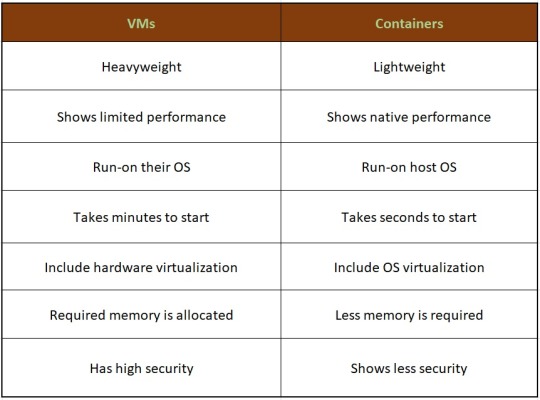
Hence, looking at all these differences one can make out that, containers have added advantage over the old virtualization technology. As containers are faster, more lightweight and easy to manage than VMs and are way beyond these previous technologies in many ways.
In the case of hypervisor, virtualization is performed through physical hardware having a separate operating system that can be run on the same physical carrier. Hence each hardware requires a separate operating system to run an application and its associated libraries.
Whereas containers virtualize operating systems instead of hardware, thereby each container only contains the application, its library and dependencies.
Containers in a similar way to a virtual machine will allow developers to improve the CPU and use physical machines' memory. Containers through their managed service provider further allow microservice architecture, allowing application components to be deployed and scaled more granularly.

As we have seen the benefits and differences between the two technologies, one must know when to use containers and when to use virtual machines, as many people want to use both and some want to use either of them.
Let’s see when to use hypervisor for cases such as:
Many people want to continue with the virtual machines as they are compatible and consistent with their use and shifting to containers is not the case for them.
VMs provide a single computer or cloud hosting server to run multiple applications together which is only required by most people.
As containers run on host operating systems which is not the case with VMs. Hence, for security purposes, containers are not that safe as they can destroy all the applications together. However, in the case of virtual machines as it includes different hardware and belongs to secure cloud software, so only one application will be damaged.
Container’s turn out to be useful in case of,
Containers enable DevOps and microservices as they are portable and fast, taking microseconds to start working.
Nowadays, many web applications are moving towards a microservices architecture that helps in building web applications from managed service providers. The containers help in providing this feature making it easy for updating and redeploying of the part needed of the application.
Containers contain a scalability property that automatically scales containers, reproduces container images and spin them down when they are not needed.
With increasing technology, people want to move to technology that is fast and has speed, containers in this scenario are way faster than a hypervisor. That also enables fast testing and speed recovery of images when a reboot is performed.

Hence, will containers replace hypervisor?
Although both the cloud hosting technologies share some similarities, both are different from each other in one or the other aspect. Hence, it is not easy to conclude. Before making any final thoughts about it, let's see a few points about each.

Still, a question can arise in mind, why containers?
Although, as stated above there are many reasons to still use virtual machines, containers provide flexibility and portability that is increasing its demand in the multi-cloud platform world and the way they allocate their resources.
Still today many companies do not know how to deploy their new applications when installed, hence containerizing applications being flexible allow easy handling of many clouds hosting data center software environments of modern IT technology.
These containers are also useful for automation and DevOps pipelines including continuous integration and continuous development implementation. This means containers having small size and modularity of building it in small parts allows application buildup completely by stacking those parts together.
They not only increase the efficiency of the system and enhance the working of resources but also save money by preferring for operating multiple processes.
They are quicker to boost up as compared to virtual machines that take minutes in boosting and for recovery.
Another important point is that they have a minimalistic structure and do not need a full operating system or any hardware for its functioning and can be installed and removed without disturbing the whole system.
Containers replace the patching process that was used traditionally, thereby allowing many organizations to respond to various issues faster and making it easy for managing applications.
As containers contain an operating system abstract that operates its operating system, the virtualization problem that is being faced in the case of virtual machines is solved as containers have virtual environments that make it easy to operate different operating systems provided by vendor management.
Still, virtual machines are useful to many
Although containers have more advantages as compared to virtual machines, still there are a few disadvantages associated with them such as security issues with containers as they belong to disturbed cloud software.
Hacking a container is easy as they are using single software for operating multiple applications which can allow one to excess whole cloud hosting system if breaching occurs which is not the case with virtual machines as they contain an additional barrier between VM, host server and other virtual machines.
In case the fresh service software gets affected by malware, it spreads to all the applications as it uses a single operating system which is not the case with virtual machines.
People feel more familiar with virtual machines as they are well established in most organizations for a long time and businesses include teams and procedures that manage the working of VMs such as their deployment, backups and monitoring.
Many times, companies prefer working with an organized operating system type of secure cloud software as one machine, especially for applications that are complex to understand.
Conclusion
Concluding this blog, the final thought is that, as we have seen, both the containers and virtual machine cloud hosting technologies are provided with different problem-solving qualities. Containers help in focusing more on building code, creating better software and making applications work on a faster note whereas, with virtual machines, although they are slower, less portable and heavy still people prefer them in provisioning infrastructure for enterprise, running legacy or any monolithic applications.
Stating that, if one wants to operate a full operating system, they should go for hypervisor and if they want to have service from a cloud managed service provider that is lightweight and in a portable manner, one must go for containers.
Hence, it will take time for containers to replace virtual machines as they are still needed by many for running some old-style applications and host multiple operating systems in parallel even though VMs has not had so cloud-native servers. Therefore, it can be said that they are not likely to replace virtual machines as both the technologies complement each other by providing IT managed services instead of replacing each other and both the technologies have a place in the modern data center.
For more insights do visit our website
#container #hypervisor #docker #technology #zybisys #godaddy
6 notes
·
View notes
Text
Why WordPress Is Still the Best CMS for Business Websites in 2025

In a world full of website builders and content management systems (CMS), one name has stood the test of time — WordPress. Despite newer tools entering the market, WordPress continues to lead the way in 2025 as the most trusted platform for building professional, secure, and scalable websites.
But what makes WordPress such a powerful CMS? And why do businesses across all industries — from tech startups to cafes and tour operators — still rely on it?
What is a CMS, and Why Do You Need One?
A Content Management System (CMS) is a software platform that allows users to create, manage, and modify content on a website without needing to code everything from scratch.
Whether it’s updating a product page, writing a blog post, or adding new services, a CMS makes it simple and quick.
Popular CMS Options in 2025 Include:
WordPress
Wix
Squarespace
Shopify (for eCommerce)
Webflow
Among these, WordPress remains the most flexible and scalable, powering over 40% of all websites globally.
Top 7 Reasons Why WordPress Still Dominates in 2025
1. It’s Completely Open-Source and Free
One of WordPress’s biggest advantages is that it’s open-source — you have full control over your site’s design, content, and data.
There are no restrictions on how you use it. You can:
Customize every detail
Migrate your site anytime
Add as many users, pages, or plugins as needed
This level of freedom is unmatched by many other platforms.
2. Limitless Design Flexibility
With over 10,000+ themes and visual builders like Elementor and WPBakery, WordPress gives you endless creative control.
Want a minimalist portfolio? A vibrant online store? A multilingual booking system? WordPress can do it all — and look good while doing it.
3. Thousands of Plugins to Expand Your Site
From SEO and analytics to appointment booking and chat support — WordPress’s 60,000+ plugins let you build exactly what you need.
Popular plugin categories include:
SEO: Yoast, Rank Math
Ecommerce: WooCommerce
Security: Wordfence, Sucuri
Speed: LiteSpeed Cache
Forms: WPForms, Gravity Forms
You’re never limited by your theme — you can add new features anytime.
4. Built-In SEO Superpowers
WordPress is SEO-friendly out of the box. Combine that with tools like Yoast SEO, fast-loading themes, and schema plugins — and you’re looking at a website that’s ready to rank on Google.
Plus, it’s easy to:
Add meta titles and descriptions
Create sitemaps
Control URL structures (permalinks)
Optimize image alt tags
For businesses looking to grow organically, WordPress is the most reliable option.
5. Mobile-Responsive and Fast
Most WordPress themes in 2025 are designed to work seamlessly across all screen sizes — from phones to tablets to desktops. Speed optimization plugins like WP Rocket and LiteSpeed Cache make your website lightning fast — a key factor in both SEO and user retention.
6. Ideal for E-Commerce and Service Businesses
Want to sell products online? WooCommerce — WordPress’s native eCommerce plugin — is robust, easy to use, and supports everything from physical goods to digital services.
And if you’re a service-based business, you can add features like:
Appointment scheduling
Live chat
Online payments
Google Maps integration
All with just a few plugin installations.
7. Large Community and Ongoing Support
WordPress is backed by a massive global community. That means:
Regular software updates
Thousands of tutorials and guides
Developers ready to troubleshoot issues
Countless forums and YouTube channels for self-help
It’s a CMS that’s constantly evolving — and won’t be obsolete next year.
What Types of Businesses Use WordPress in 2025?
The beauty of WordPress is its universal adaptability. It’s used by:
Restaurants and cafes for menu display and reservations
Tour companies for blog posts, package listings, and online bookings
Real estate agents for showcasing properties
Startups for portfolio sites and landing pages
Hospitals and clinics for appointment systems and patient information
Online stores selling everything from handmade items to courses
Even major companies like TechCrunch, Sony, and The New Yorker still trust WordPress.
WordPress vs. Other CMS Platforms
FeatureWordPressWixShopifyWebflowOwnershipFullLimitedLimitedFullFlexibilityHighMediumE-commerce onlyHighCostLow to scalableMediumHighHighPlugin SupportMassiveLimitedApp-basedModerateCommunity SupportGlobalLimitedModerateModerate
WordPress wins for long-term growth and business scalability.
Should You DIY or Hire a Professional?
WordPress is beginner-friendly — but building a website that is fast, secure, mobile-optimized, and SEO-ready from day one takes expertise.
That’s where a professional web design company in Udaipur comes in. A team that understands design, development, SEO, and user behavior can help you:
Customize themes and plugins
Set up proper security and backup systems
Speed-optimize for Google ranking
Build landing pages that convert
You focus on your business — let the experts handle the tech.
Final Words: WordPress Is Still King in 2025
Trends come and go. Website builders rise and fall. But WordPress continues to rule the CMS world — and for good reason.
0 notes
Text
How a Real Estate CRM Tool Simplifies Property Management and Sales
In the real estate industry, managing leads, maintaining client relationships, and streamlining transactions are critical to success. A Real Estate CRM tool offers a centralized system designed specifically to address these needs by organizing customer data, automating repetitive tasks, and supporting long-term client engagement.
This article explores how a specialized CRM tool helps real estate professionals operate more efficiently and stay competitive in a complex market.
What Is a Real Estate CRM Tool?
A Real Estate CRM (Customer Relationship Management) tool is a software platform tailored to meet the needs of brokers, agents, developers, and property managers. Unlike generic CRM systems, real estate CRMs are equipped with features that specifically support real estate workflows such as lead tracking, property matching, client communication, and transaction management.
Key Features of a Real Estate CRM Tool
Lead Management
Automatically capture leads from websites, landing pages, and third-party platforms.
Organize and score leads based on interest, budget, and engagement to focus on high-priority clients.
Property Matching
Match prospective buyers or tenants with available properties using filters like location, price, and amenities.
Send automated property suggestions that align with client preferences.
Communication Tracking
Maintain a timeline of all communications—calls, emails, messages—with each client.
Schedule follow-ups and reminders for better engagement and timely responses.
Document and Task Management
Store agreements, contracts, and property documents securely.
Assign and track tasks related to site visits, paperwork, or negotiations.
Analytics and Reporting
Monitor performance through detailed reports on sales pipelines, agent productivity, and lead conversion rates.
Identify patterns and improve decision-making using data-driven insights.
Mobile Accessibility
Access CRM features from any device while on-site or in meetings.
Update lead details or share property information instantly.
Benefits for Real Estate Professionals
1. Centralized Information
A CRM tool consolidates customer data, communication history, and transaction records into one platform, reducing the risk of errors or missed opportunities.
2. Enhanced Productivity
Automation of routine tasks—like sending follow-up emails or assigning leads—allows agents to focus on more strategic activities like relationship building and closing deals.
3. Improved Client Experience
With timely updates, personalized property recommendations, and organized communication, clients experience better service and quicker responses.
4. Better Team Collaboration
Multiple users can access the same client and property information, making it easier for teams to collaborate and stay updated.
Who Should Use a Real Estate CRM Tool?
Independent Agents: To manage leads and grow a personal brand.
Brokerages: To organize sales processes across multiple agents.
Property Developers: To handle large volumes of customer inquiries and project updates.
Leasing Managers: To track rental inquiries, schedule viewings, and manage lease agreements.
Why Zestato?
Zestato.com offers a purpose-built Real Estate CRM tool that simplifies complex property workflows while ensuring user-friendly navigation. It is designed to handle high volumes of data without sacrificing performance or clarity. Whether you're managing sales, rentals, or client relationships, Zestato’s CRM system helps keep every detail structured and accessible.
Conclusion
In a competitive and fast-moving industry like real estate, having a system that helps manage relationships and transactions efficiently is no longer optional—it’s essential. A dedicated Real Estate CRM tool provides the structure and support needed to stay organized, make informed decisions, and maintain strong client connections. For those looking to streamline their real estate operations with clarity and efficiency, adopting a specialized CRM tool like the one offered by Zestato is a smart step forward.
0 notes